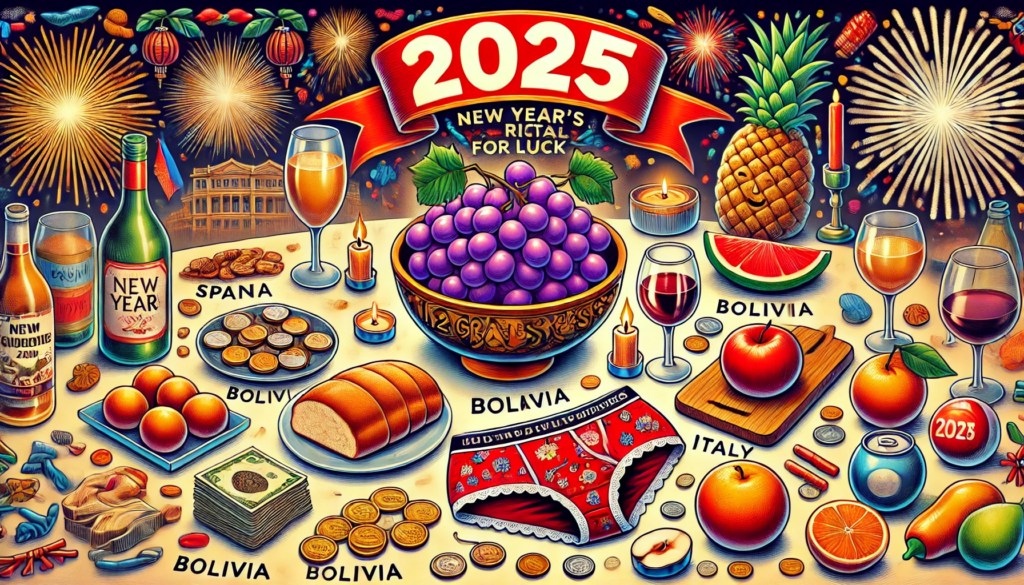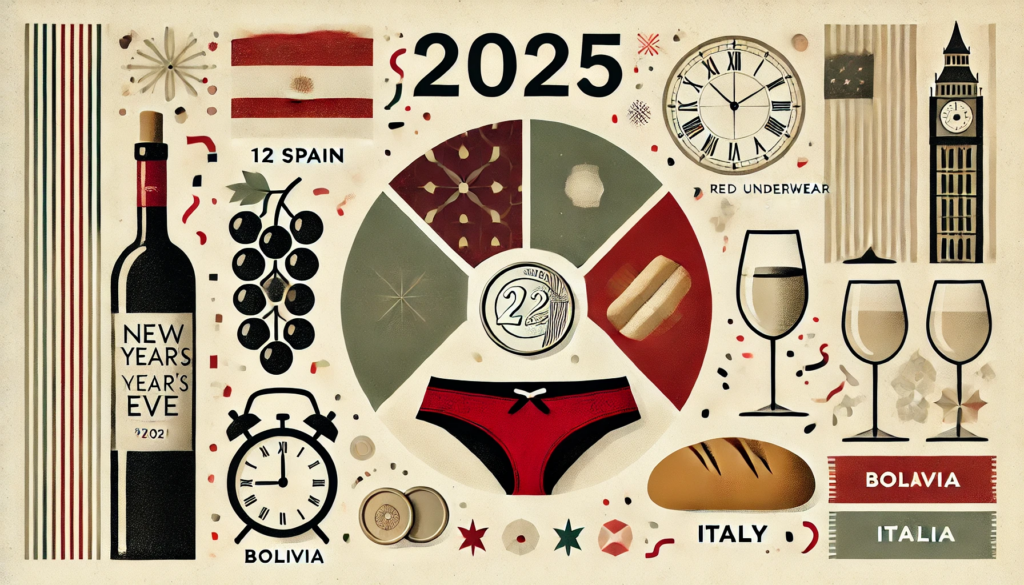
ChatGPT:
Superstitions and Good Luck Rituals for New Year’s Eve Around the World
New Year’s Eve is often associated with rituals and superstitions believed to bring luck, prosperity, and happiness for the coming year. Different cultures celebrate with unique traditions that reflect their beliefs. Here’s a look at some fascinating customs around the world:
1. Spain – Eating 12 Grapes at Midnight
• Ritual: Spaniards eat 12 grapes, one for each stroke of midnight, to symbolize good luck for every month of the new year.
• Belief: Successfully finishing all 12 grapes ensures prosperity and wards off bad luck.
2. Italy – Wearing Red Underwear
• Ritual: Italians wear red underwear on New Year’s Eve.
• Belief: Red symbolizes love, fertility, and good fortune, making it popular for ensuring romance and happiness.
3. Brazil – Jumping Over 7 Waves
• Ritual: People dressed in white head to the beach, offering flowers to Yemanja, the goddess of the sea, and jump over seven waves while making wishes.
• Belief: Each wave represents a blessing and a wish for the year ahead.
4. Greece – Hanging an Onion
• Ritual: Greeks hang a large onion on their doors after midnight as a symbol of rebirth.
• Belief: The onion’s growth represents fertility and new beginnings. Children are also gently tapped on the head with the onion for good luck.
5. Philippines – Displaying Round Objects
• Ritual: Filipinos decorate their homes with round fruits and objects.
• Belief: Round shapes symbolize coins, representing wealth and prosperity. Wearing polka dots is also thought to attract money.
6. Denmark – Breaking Plates
• Ritual: Danes smash plates against the doors of friends and family.
• Belief: The more broken plates you find at your doorstep, the more luck and loyalty you’ll have in the coming year.
7. Japan – Ringing Bells 108 Times
• Ritual: At midnight, Buddhist temples ring their bells 108 times.
• Belief: The number represents human sins, and the ritual cleanses the soul, ensuring purity and a fresh start.
8. Colombia – Carrying an Empty Suitcase
• Ritual: Colombians walk around their block carrying an empty suitcase.
• Belief: It’s thought to bring travel opportunities and adventure in the new year.
9. Russia – Writing Wishes and Burning Them
• Ritual: Russians write down a wish on paper, burn it, and mix the ashes into champagne before drinking it.
• Belief: This ensures the wish will come true.
10. Scotland – First-Footing Tradition
• Ritual: The first visitor, or “first-footer,” who enters a home after midnight brings symbolic gifts like coal, bread, and whisky.
• Belief: A dark-haired first-footer is thought to bring the most luck and prosperity.
More Superstitions and Good Luck Rituals for New Year’s Eve Around the World
1. Germany – Melting Lead (Bleigießen)
• Ritual: Germans melt lead or tin and pour it into cold water. The shapes formed are interpreted as symbols of the future (e.g., a heart for love or a ring for marriage).
• Belief: This fortune-telling practice helps predict what the year will bring.
2. Chile – Eating Lentils
• Ritual: Chileans eat lentils at midnight.
• Belief: Lentils symbolize wealth and abundance due to their coin-like shape, ensuring financial success.
3. Ecuador – Burning Effigies (Año Viejo)
• Ritual: People create effigies (dolls or figures) representing the old year, filled with paper and fireworks, and set them on fire at midnight.
• Belief: Burning the effigies clears away bad energy, misfortune, and negative experiences to make room for a fresh start.
4. Argentina – Stepping with the Right Foot
• Ritual: At midnight, Argentinians step into the new year with their right foot first.
• Belief: Starting the year on the right foot is a symbol of good luck and positivity.
5. Mexico – Sweeping Out Bad Luck
• Ritual: Many Mexicans sweep their homes just before midnight to remove negativity and bad luck.
• Belief: Cleaning the house symbolizes clearing out old energy and welcoming prosperity.
6. Ireland – Banging Bread Against Walls
• Ritual: People in Ireland bang loaves of bread against the walls and doors of their homes.
• Belief: This wards off evil spirits and invites good fortune into the household.
7. Venezuela – Wearing Yellow Underwear
• Ritual: Venezuelans wear yellow underwear on New Year’s Eve.
• Belief: Yellow is thought to attract wealth and happiness for the year ahead.
8. Peru – Fortune Fights
• Ritual: In some rural areas of Peru, people engage in friendly fistfights during festivals.
• Belief: The fights help resolve conflicts, allowing everyone to enter the new year with a clean slate and restored harmony.
9. Puerto Rico – Throwing Water Out of Windows
• Ritual: People throw buckets of water out their windows.
• Belief: This symbolizes driving away evil spirits and bad energy, making way for a peaceful and prosperous year.
10. South Africa – Tossing Old Furniture
• Ritual: In some areas, especially in Johannesburg, people throw old furniture out of their windows.
• Belief: Disposing of old belongings represents letting go of the past and making space for new opportunities.
11. Japan – Eating Long Noodles (Toshikoshi Soba)
• Ritual: Japanese people eat buckwheat noodles called Toshikoshi Soba before midnight.
• Belief: The long noodles symbolize longevity and breaking away from hardships of the past year.
12. Bolivia – Baking Coins into Cakes
• Ritual: Bolivians bake coins into cakes or pastries.
• Belief: Whoever finds the coin in their slice is believed to have good fortune for the year ahead.
13. Turkey – Sprinkling Salt
• Ritual: At midnight, Turks sprinkle salt on their doorsteps.
• Belief: This brings peace and abundance to the home in the coming year.
14. Haiti – Making Soup Joumou
• Ritual: Haitians prepare and share Soup Joumou, a pumpkin-based soup, on New Year’s Day.
• Belief: It’s a symbol of freedom, unity, and prosperity, as the soup commemorates Haiti’s independence.
15. Thailand – Water Fights During Songkran (New Year in April)
• Ritual: Thai people engage in water fights during their New Year celebrations in April.
• Belief: Water symbolizes cleansing and renewal, washing away bad luck.
Why Do These Rituals Persist?
Whether rooted in ancient beliefs or modern customs, these rituals highlight humanity’s universal hope for happiness, wealth, and good fortune in the coming year. They also add meaning and fun to celebrations, keeping cultural traditions alive.

